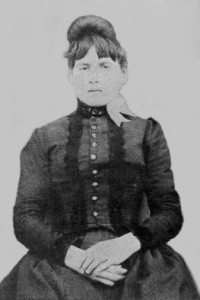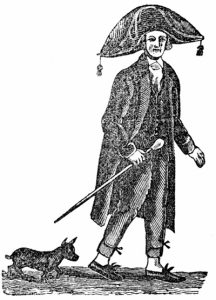Greenbrier County, West Virginia was a densely populated area. Nothing out of the ordinary ever occurred there until 1897, when a shocking death created an outburst and made headlines. Elva Zona Heaster was victim to a horrible murder that had originally been judged as “death by natural causes.”1
In 1895, Heaster gave birth to an illegitimate child. The next year she met Erasmus Stribbling Shue, and the couple soon married and were known to be inseparable. Despite the love the couple had for one another, Mary Jane Robinson Heaster, Zona Heaster’s mother, was not very impressed by Erasmus Shue, and disapproved of their marriage. Despite this, the couple continued to live together.

Erasmus Shue had initially moved to Greenbrier County to work as a blacksmith. Months went by and the couple seemed to live a normal life. On January 23, 1897, Shue sent a young boy that worked with him in the blacksmith shop to run an errand for him. The young boy obliged and walked to the couple’s house to do as he was told. Upon entering the house, the boy found Heaster lying at the bottom of a stairwell. Knowing that Heaster was dead, the young boy ran to his mother and notified her of what he had seen. The local doctor, police, and Shue were notified. Shue was the first to arrive on the scene; he carried his wife up the stairs and laid her on their bed, where he proceeded to dress her. His actions were very out of the ordinary considering the custom was for the ladies of the community to dress her in appropriate burial wear. Shue dressed her in a stiff-collared dress and a large veil. The local doctor, Dr. Knapp, was sent to examine the body, but was having difficulties since Heaster’s husband refused to let go of her, cradling her head and hysterically crying. As a result, Dr. Knapp declared her cause of death to be “an everlasting faint,” but then changed his statement to “childbirth.” What was particularly interesting was that Heaster had told no one that she was pregnant, nor did she appear to have signs or symptoms of pregnancy. Soon after, Heaster’s mother was notified and she immediately blamed Shue for Zona’s death.2
Mary Jane, Heaster’s mother, began praying and asking God to give her the name of the person guilty of her daughter’s murder. About four weeks after the death of her daughter, Mary Jane claimed to have had visions of a ghostly appearance telling her that Shue had killed her daughter. This occurrence happened four nights in a row, and began to make Mary Jane very ill. She decided to take her testimony to a prosecutor, John Alfred Preston. The prosecutor was hesitant about taking her case, but decided to do research on his own before believing Mary Jane. He went around the town asking for testimonies on the matter and found that Dr. Knapp admitted to not having been able to conduct a complete examination of the body. Neighbors noticed that during the viewing of Heaster, Shue never left the side of the coffin and didn’t let anyone look at her closely. As the pieces of the mysterious death finally fell into place, the prosecutor decided to take on the case. The prosecutor was able to obtain a warrant that allowed the body to be exhumed for re-examination.3
After a complete autopsy was performed, doctors found that Heaster’s neck had been broken and the bruising around her neck indicated that her windpipe had been severely crushed, as if she had been strangled. After the autopsy had been concluded, Shue was arrested and taken into custody for a later trial.4
The trial started on June 23, 1897, and lasted for eight days before the jury decided on a verdict. During the trial, the prosecutor tried to avoid using Mary Jane’s testimony due to the misunderstanding the jury might have. Regardless of these allegations, Mary Jane went ahead and revealed how she knew that Shue had murdered her daughter. Shue’s attorney immediately rejected the idea claiming that Mary Jane was crazy and unstable. The jury, however, found her story credible but did not mention it again after the first statement. The evidence against Shue was overwhelming and on the last day of the trial the jurors finally decided on a verdict. Ten of the twelve jurors voted on execution, but since it was not a unanimous decision, Shue was eventually sentenced to life in prison for first degree murder of Elva Zona Heaster.5
After the sentence, Shue was sent to prison, but the overwhelming disagreement on behalf of the community caused an outraged. Greenbrier County citizens felt that Shue should be hanged for his crime. On July 11, 1897, an angry mob gathered and threatened to lynch Shue, but the sheriff heard what was happening, and hid Shue in the woods before the mob could reach him. The Sheriff calmed the mob and eventually everyone went home.6
On July 13, 1897, Shue was placed in the state penitentiary where he eventually died of natural causes on March 13, 1900.7
The ordeal of the Greenbrier Ghost has sparked interest in many paranormal investigators and has made West Virginia a popular tourist attraction. No real evidence has been found on the Greenbrier ghost that Mary Jane claimed revealed her daughter’s murderer. The case is particularly interesting because at the time, investigators could not have revealed the murderer, due to the obvious lack of technology or forensic evidence. The only person that could have any other reliable testimony on the case would be the young boy that found Zona Heaster dead. From what was uncovered, the case can only be concluded as “Murder Solved by Ghost.”
- Katie Lyle, Man Who Wanted Seven Wives: The Greenbrier Ghost and the Famous Murder Mystery of 1897 (Charleston, W. Va: Quarrier, 1999), 6. ↵
- Katie Lyle, Man Who Wanted Seven Wives: The Greenbrier Ghost and the Famous Murder Mystery of 1897 (Charleston, W. Va: Quarrier, 1999), 6. ↵
- “EDITORIAL: West Virginia ghost stories recounted in new book,” Charleston Gazette, The (WV), November 01. Newspaper Source, EBSCOhost (accessed October 10, 2017). ↵
- Mike Conley, “Mike Conley’s Tales of the Weird: Ghost brings murderer to justice,” McDowell News, The (NC), August 27. Newspaper Source, EBSCOhost (accessed October 10, 2017). ↵
- Katie Lyle, Man Who Wanted Seven Wives: The Greenbrier Ghost and the Famous Murder Mystery of 1897 (Charleston, W. Va: Quarrier, 1999), 6. ↵
- “EDITORIAL: West Virginia ghost stories recounted in new book,” Charleston Gazette, The (WV), November 01. Newspaper Source, EBSCOhost (accessed October 10, 2017). ↵
- Mike Conley, “Mike Conley’s Tales of the Weird: Ghost brings murderer to justice,” McDowell News, The (NC), August 27. Newspaper Source, EBSCOhost (accessed October 10, 2017). ↵



96 comments
Tyler Sleeter
Really great article. I was not familiar with this case until reading your article and I feel like it is something we should know about. It is fascinating to me that someone could die from an “everlasting faint” and I think it is terrible that women could be written off so easily as the weaker sex. I think it would be interesting to see if a case like this would even make it to court today if the main witness said she was told by a ghost who killed the woman. Modern society is more accepting of psychic phenomena, in my opinion, but the court of law is not.
Joel Gracia
The story told by this article is fascinating. I am a huge fan of mystery and crime, and this perplexing murder is combination of both. I would love to research the case and trial even deeper so that I could understand exactly what motives they thought that Shue had for the murder, because I could not imagine any at this point; it seems they had a good relationship before this tragedy.
Benjamin Voy
What a great article, I have never actually heard of this case, or even a case remotely like this. I believe Shue was definitely guilty though as the way he handled the death and the way he handled himself during the enquires was very suspect. I do also believe that if this was a case in our modern day it would have been solved a lot faster due to all of our modern technology and DNA etc. Great article on a very fascinating topic.
Sebastian Castro Ramos
How interesting how this case was solved: because of the apparition of a ghost to Heaster’s mother. I have never believed much in the paranormal, so I would be more inclined to believe that it was Mary Jane’s unconscious saying it was Heaster’s husband the one who murdered her because she despised him. Shue’s actions suggest it was actually him who murdered his wife because he didn’t permit aybody to get close to Heaster, but there is a chance that the murderer could have actually been somebody else, and Shue been wrongfully imprisoned. Great article!
Mark Martinez
A well written and put together article that was interesting to read. I never heard of this story before but you did an amazing job telling it. At first your think the husband was under to much grief to function but no he was the killer all along. It makes you wonder if Marry Jane saw the ghost of her child or her grief brought out what she new all along.
Zeresh Haman
This is a very interesting article. I have never heard of anything like this. It really is sad how a husband could murder his wife in such a violent way. I find it very fascinating how this ghost came and told Hester’s mother who killed her daughter, but even for interesting then that is the fact the her testimony held up in court. I feel that if something like that happened today then the jury would not use it as evidence, they would say that there is not enough proof. Very well written, and easy to follow.